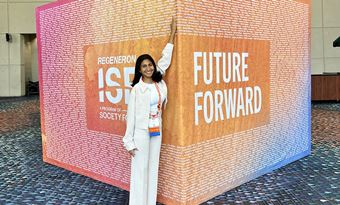 Congratulations to Maya Butani, a winner in this year’s Coriell Institute Science Fair, for her recent first place award at the 2022 International Science and Engineering Fair! Maya received the first place award in the Biochemistry category for her work investigating the utility of plant tissue in human tissue engineering.
Congratulations to Maya Butani, a winner in this year’s Coriell Institute Science Fair, for her recent first place award at the 2022 International Science and Engineering Fair! Maya received the first place award in the Biochemistry category for her work investigating the utility of plant tissue in human tissue engineering.
Maya admits she caught the science fair bug young. She first participated in the Coriell Institute Science Fair six years ago, when she was in Sixth Grade. Now a senior at Moorestown High School, Maya has focused her work on the field of engineering human-like tissue—specifically for finding out if tissue can be grown using plant material that could be used safely in humans.
This year’s win is a bit of a repeat for Maya. Though she won an additional special award this year, she won first place in the same category last year. The event in May, however, was different in one big way.
“I didn’t know what I was missing because it wasn’t held in person last year,” Maya said. “Meeting everyone in person is unmatched. Virtually, you can’t get the same experience meeting people around the world. At the event in Atlanta, I met people from Portugal, Egypt, Italy, and Saudi Arabia. I was able to have in-depth conversations with all these people.”
For her project, Maya utilized stem cells from the connective tissue and grocery store celery. Maya sliced the celery in two ways—across the entire bunch and straight down the ribs lengthwise—to create two different surfaces to culture these stem cells. Looking down at the celery sliced across, the surface has a porous structure that is bonelike in appearance, and lengthwise, the structure is long and fibrous, like muscles.
.jpg?mw=280) When culturing stem cells on these two surfaces, she found that the stem cells on the porous celery sliced across were more likely to develop into bone cells and the stem cells cultured on the celery sliced lengthwise were more likely to grow into the types of cells found in muscles. Maya stained proteins and confirmed that when compared to synthetic tissue engineering bases, the stem cells responded better when cultured on the celery—there was more mechanosensing, meaning the cells had a stronger response to their physical environment.
When culturing stem cells on these two surfaces, she found that the stem cells on the porous celery sliced across were more likely to develop into bone cells and the stem cells cultured on the celery sliced lengthwise were more likely to grow into the types of cells found in muscles. Maya stained proteins and confirmed that when compared to synthetic tissue engineering bases, the stem cells responded better when cultured on the celery—there was more mechanosensing, meaning the cells had a stronger response to their physical environment.
“I found that not only is it viable to use plant material for tissue engineering, but there are advantages which is a fascinating conclusion of my research over the last four years,” Maya said.
This is certainly lofty work for a high school student, but Maya has help.
“I started doing this research in my kitchen, trying to create these plant scaffolds. I monopolized the kitchen, much to my parents’ dismay,” Maya said. “I realized if I wanted to really do this work, I’d need access to a lab. I completed a summer camp at Rowan University and I talked to one of the professors there. She reached out to researchers for me and Dr. Sebastian Vega talked to me. We’ve been able to grow the project as a team since then.”
Dr. Vega’s lab at Rowan has given Maya access to the tools needed to conduct her experiments, and the support and guidance of her peers, fellow undergraduate and graduate scientists passionate about tissue engineering.
“Dr. Vega is incredibly supportive and is a great mentor,” Maya said. “I appreciate it the most that they take the ideas of a highschooler seriously. I really felt heard and appreciated there, and the following opportunities have been unimaginable.”
From here, Maya graduates in June and will attend Princeton University in the Fall, allowing her to stay close to home, with an initial focus on studying Molecular Biology.
“The people I’ve met have changed my life. My mentors who have taught me and have given me opportunities, to the other science fair competitors who share my passion, and the judges who make me feel like I’m on the cutting edge of science,” Maya said. “It’s the people and the network that truly make the research.”